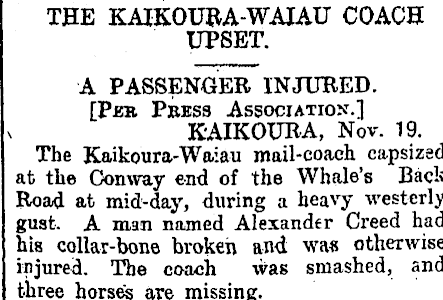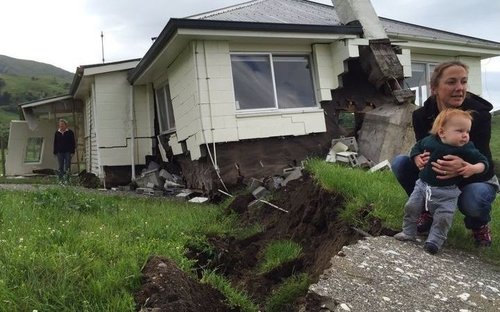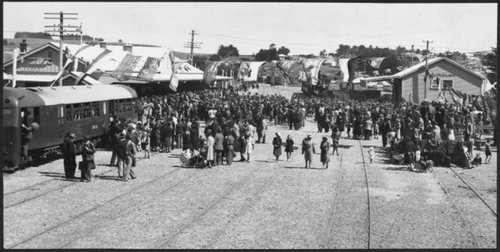
By Sarah Johnston
The hilly territory between Canterbury and Marlborough that has been badly affected by the recent earthquake, has long had a reputation as being difficult country for transport, despite its scenic beauty. Since the early years of European settlement, residents have grappled with the steep Kaikoura coast and the rivers and hills of the “Inland Route,” as is captured in sound and film recordings held in the archives of Ngā Taonga Sound & Vision.
In a 1950 radio interview, Albert Creed, whose family owned North Canterbury transport company Creed and Derrett, talks about the journeys in the days of horse-drawn coaches and bullock wagons.
Mr Creed recalls the poor state of the roads in the region in his father’s time. It could take six or seven weeks by bullock wagon to cart wool bales from Hanmer to Salt Water Creek (just north of Christchurch) and the inland route from Waiau to Kaikoura was vulnerable to high winds, slips and floods on the Conway River, as many newspaper articles of the era attest.
Hero image: Morris Minor car, Kaikoura Coast Road, Hundalee Hills, Marlborough 1950. Whites Aviation Ltd. National Library.

Star, Issue 7257, 19 November 1901 (courtesy Papers Past)
Mr Creed began driving the mail coaches himself as a young man. When labourers from Christchurch were brought in to extend the coastal road to Kaikoura through the Hundalee Hills, he transported them as well. Mr Creed recalls fights breaking out in the back of the coach among drunken road workers who had “pre-loaded” for the trip, with some eventually falling out while he crossed a swamp. In this excerpt from his 1950 interview, he remembers how his brother nearly drowned in the Mason River while on a mail run, when the washed-out road gave way beneath his horse.
Interview with Albert Creed from Canterbury Pilgrimage No 23 Waiau (3YA Christchurch, 1950)

View of the Clarence Bridge under construction, Main Trunk Line, Marlborough. 1940. Evening Post newspaper.
As the road links were improved through the 1930s and 1940s, the remote access meant workers had to be housed in temporary villages. You can see these, plus the stunning but difficult terrain, in this 1939 aerial film shot by the Ministry for Public Works.
Aerial Shots of Kaikoura Coast Road Construction (Ministry for Public Works, 1939)
One of the many faultlines triggered in this month’s 7.8 quake, was one which ran under homes on Bluff Station near Kekerengu, north of Kaikoura. RNZ visited the shocked owners whose home had jumped 10 metres off its foundations.

A house at Bluff Station between Blenheim & Kaikoura, which is right on the Kekerengu fault line, was demolished by the shakes (photo: RNZ / Alex Perrottet)
Bluff Station was first visited by the NZBC back in 1956, along with one of their newly acquired portable tape recorders. Bruce Petrie accompanied shepherds and their dogs as they mustered a mob of 4,000 ewes down from the remote high country to shearing sheds at Kekerengu. The resulting radio documentary High Country Sheep Drive features a lot of early use of actuality recorded on location and you can listen to it here.

Arrival of the first passenger train to Kaikoura, 1945. Evening Post newspaper.
The scenic coastal railway line from Picton through Kaikoura has also been troubled by the steep country through which it passes. It was not until 1945 that the final link in the Main Trunk Line from Picton to Bluff was completed, when the stretch through Kaikoura to Parnassus was finally built. You can watch the celebrations in Kaikoura on a Weekly Review newsreel on Archive NZ’s YouTube channel.
In 1954 W.T. Knowles and family took a road trip around the South Island, filming their holiday along the way – including their journey around the Kaikoura coast and past the region’s railway tunnels. Below is an excerpt from their film. You can watch the full film of their adventures in other South Island towns here.
Excerpt from W.T. Knowles Personal Record – South Island Holiday (1954)
In 1982, Radio New Zealand reporter Frank Perry reported on $20 million improvements to the railway line, which had developed a bad reputation because of the frequent delays and slips.
Tunnel 22 on Christchurch to Picton Line Disappears (Radio New Zealand, 1982)
In his 1950 interview, after recalling the difficult roads he used to ride by coach and horseback, Albert Creed ends by saying “I wonder what some of them would think, if they had to tackle these trips today?”
He would probably not be too surprised to see the region’s rugged landscape and Mother Nature are still causing headaches that even 21st century technology is struggling to overcome.